Displacement or bending of the uterus is retrodeviation. This phenomenon occurs quite often in medical practice. The causes of the phenomenon, as a rule, are associated with anomalies in the development of the organs of the reproductive system.
However, this condition can appear as a result of inflammatory processes and previous operations on the genitals. Minor deviations often do not cause any health problems, but with more serious violations of the position of the uterus, women develop infertility and the risk of miscarriages increases.
Record content:
- 1 What is uterine retrodeviation?
- 2 Causes
- 3 Types of deviations
- 4 Progression stages
- 5 Symptoms
- 6 Complications
- 7 Retrodeviation of the uterus and pregnancy
- 8 Diagnostics
-
9 Treatment
- 9.1 Shortening of ligaments
- 9.2 Hanging
- 9.3 Exohysteropexy
- 10 Exercise therapy for retroflection of the uterus
- 11 Traditional methods
- 12 Forecast
- 13 Video about the bend of the uterus
What is uterine retrodeviation?
Retrodeviation of the uterus is a phenomenon in which a violation of the position of the organ is noted. The body of the uterus is deflected posteriorly, the cervix is anteriorly, subsequently an angle is formed that opens backward - this is retroflection. The origin of the term retrodeviation from Latin is explained as follows: retro - back, devio - deviation, that is, deviation in the opposite direction.

Often the pathological condition is congenital, the problem rarely occurs in childhood and adolescence. In adult patients, the development of retrodeviation is considered rare, it is usually associated with pregnancy or difficult childbirth.
Causes
There are many reasons for the development of retrodeviation of the uterus, they are divided into genetic and acquired.
Genetic reasons:
- improper lifestyle of a pregnant woman;
- unsatisfactory state of health of a woman during gestation;
- bad habits during pregnancy (smoking, alcohol, drugs);
- irrational intake of medicines during the period of bearing girls;
- congenital malformations of the genital organs.
Reasons for acquired retrodeviation:
- frequent exposure to infections on the organs of the reproductive system;
- difficult natural childbirth and cesarean section;
- surgical treatment of the organs of the genitourinary system;
- any surgical procedures;
- neoplasms on the uterus;
- adhesions in the genital organ;
- weakening of the ligaments that fix the organ;
- excessive physical activity, regular lifting of heavy loads;
- multiple pregnancies and spontaneous abortions;
- hooking girls too early.
Types of deviations
A condition such as retrodeviation of the uterus is a violation of the correct position of the organ in the small pelvis, in which bends (flexion) and tilts (verzia) of the organ are diagnosed.
Types of retrodeviation, taking into account the violation of the position of the uterus:
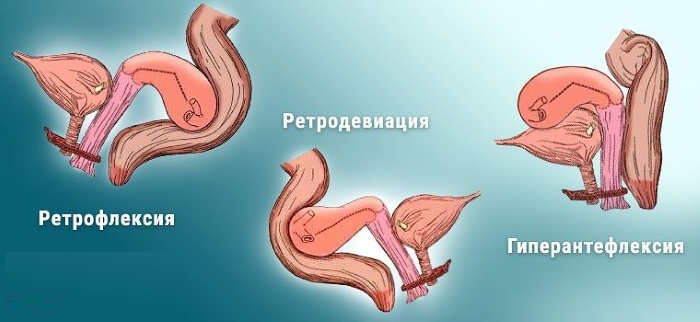
| Retrodeviation type | Description of deviations |
| Hyperantheflexia | An anterior bend of the uterus is diagnosed, in which an angle of 70 ° is formed between the body of the organ and the cervix (neck). |
| Retroflexion | There is a posterior bend of the uterus, in which an open acute angle is formed between the neck and the body. |
| Dextroversion | Deviation of the body of the genital organ to the right, and the neck to the left. |
| Retroversion | Deviation of the body of the organ posteriorly, the cervix - anteriorly. |
| Sinistverzia | There is a deviation of the body of the uterus to the left, the cervix - to the right. |
| Retroclination | A set of types of anteflexion and retroversion deviations. A deviation of the body of the uterus is diagnosed, in which an acute angle with the cervix is not formed, but relative to other organs, the uterus is deflected posteriorly. |
In medical practice, there are also such forms of violations of the position of the uterus as mobile and fixed retrodeviation.
The formation of a mobile form is due to anatomical pathological processes:
- conical shape of the cervix of an elongated size of a congenital nature;
- frequent increase in intra-abdominal pressure;
- high physical activity in girls in childhood.
The formation of fixed retrodeviation is due to:
- inflammatory process in the fallopian tubes;
- inflammation of the appendages;
- an inflammatory process in organs close to the uterus.
With mobile retrodeviation, the uterus does not lose its anatomical ability to displace, but with a fixed shape, the uterus is in one state and is not able to move. The organ is tightly bound by adjacent tissues.
A mobile uterus means an increase in its motor ability, in which the organ can change its standard position to an incorrect one. Normally, the genital organ is fixed in the small pelvis by ligamentous tissues, therefore, its displacement does not occur. But with any provoking factor that disrupts the condition of the ligaments, new connective tissues are formed, which leads to pathological displacement of the uterus.
The mobile uterus has several degrees of mobility:
- limited;
- full;
- excessive.
With excessive and complete mobility, the movement of the uterus occurs under any load, for example, with pressures or coughing. The deviation of the organ can be posterior, anterior, right or left.
Progression stages
Retrodeviation of the uterus is considered in 3 stages:
- Retroclination.
- Retroversion.
- Retroflection.
At the first stage (retroclination), the deviation of the body of the uterus does not form an acute angle with the cervix. The second stage (retroversion) is also not dangerous by the formation of an acute angle between the body and the neck. But at the third stage (retroflection), an acute angle is already formed, the body of the uterus is inclined posteriorly.
The last stage is diagnosed most often, but at the same time, the clinical manifestations practically do not bother the woman. The result of the second and third stages are adhesions, they exert little pressure on nearby tissues.
The classification of prolapse of the uterus occurs according to the following principle:
- the first stage - the prolapse of the uterus is noted, but within the vagina;
- the second stage - the uterus evades and partially extends beyond the boundaries of the vagina;
- the third stage is the absolute displacement of the organ outside the vagina.
The degree of progression of retrodeviation is influenced by many factors:
- neglect of the process;
- the duration of the negative impact of provoking factors (in particular, increased intra-abdominal pressure);
- insufficient elasticity and strength of the connective tissue apparatus;
- the presence of pathological processes in neighboring organs (tumor formations in the small pelvis, increased flatulence, aneurysm);
- the number of operations performed on the organs of the genitourinary system (scar tissue disrupts the mobility of the uterus and contributes to the formation of adhesions).
Symptoms
Retrodeviation of the uterus is a phenomenon that has a different clinical nature, depending on the severity of the pathological condition and its stage. Symptoms can often be completely absent or only mild. But with painful forms, the clinical picture is growing.
You can determine the retrodeviation of the uterus by the following signs:
- lower abdominal pain, which is not always associated with menstruation;
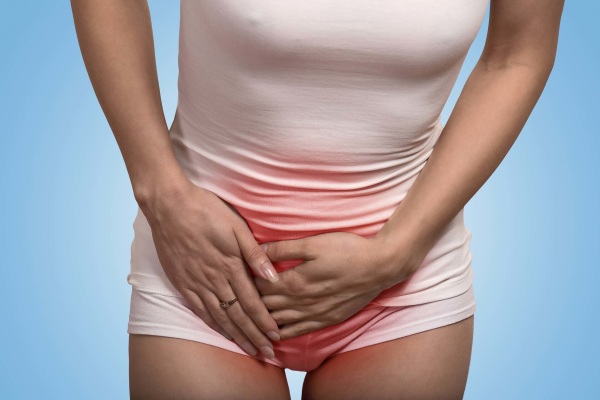
- migraine with the onset of PMS;
- soreness during ovulation;
- feeling of pain and discomfort during sexual intercourse;
- infertility;
- constipation or urinary incontinence;
- menstrual irregularities;
- pathological discharge (with a changed color, odor, volume, consistency);
- decreased libido, anorgasmia.
Complications
Retrodeviation of the uterus is a pathological condition that is primarily dangerous for the development of female infertility or problems with bearing a fetus. Often, women with such deviations have a high risk of spontaneous abortion.
Possible complications of retrodeviation:
- adnexitis;
- salpingo-oophoritis;
- irregular periods accompanied by pain;
- intestinal colic;
- inflammation of the urinary;
- tumor formations in the organs of the reproductive system (fibroids, neoplasms on the ovaries, polyps);
- endometriosis;
- erosion;
- vaginosis;
- the formation of adhesions;
- obliteration of blood vessels;
- ischemia of the intestines and urinary tract;
- dysbiosis;

- kidney inflammation;
- genital prolapse;
- dysuretic disorders against the background of inflammation of the urinary and urethra;
- violation of blood flow in the uterus when it is infringed.
Despite the extensive list of complications, retrodeviation often leads to female infertility.
Retrodeviation of the uterus and pregnancy
Retrodeviation can affect pregnancy in different ways. Problems with conception will not arise if the deviation of the uterus is insignificant, and in such a condition an acute angle is not formed between the body and the cervix.
Often women are diagnosed with a bend in the uterus, but this does not mean at all that they are unable to conceive and bear a child. In such situations, gynecologists advise using certain postures, in particular, knee-elbow or on the side.
After contact, it is recommended to raise your legs up and stay in this position for about 3-4 minutes. The favorable posture depends on the type of uterine fold. After conception during the gestation period, the uterus takes on its natural position.
The problem with conception becomes more complicated in the presence of adhesions, inflammatory processes of the genital organs and previous operations. In this case, the risk of spontaneous abortion and the development of infertility increases.
There are several ways to solve the problem. However, before doing anything, a woman is fully diagnosed and the cause is found out. Only after the results are obtained, appropriate treatment is prescribed, often surgical.
Diagnostics
Every woman is obliged to undergo a gynecologist's examination regularly with a frequency of once every six months. With a bimanual examination, the doctor can determine the deviation of the body of the uterus posteriorly and the incorrect location of the cervix. When probing, one feels the density of the organ, the presence of adhesions and how mobile it is. If there is a suspicion of bending or displacement of the uterus, the patient is prescribed an extensive diagnosis.
It includes:
-
Ultrasound - the structure of tissues is studied, the presence of myomatous formations, volumetric neoplasms, adhesions, inflammation of the tissues of the genital organs is determined;
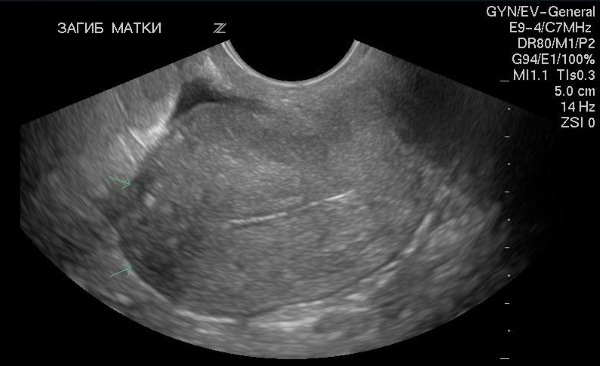
- MRI - assigned with a pronounced bend or fixed retrodeviation, provides information on the number and localization myomatous formations, determines the fixation of the uterine body due to the formation of adhesions, reveals the presence of other neoplasms;
- diagnostic laparoscopy - it is prescribed only in difficult situations in order to determine the severity of the adhesive process, sometimes it is used for medicinal purposes and to identify an ectopic pregnancy.
For diagnostic laparoscopy, the patient is hospitalized.
In addition to instrumental diagnostics, a woman is usually assigned laboratory tests:
- general blood analysis;
- Analysis of urine;
- vaginal smear.
The results of laboratory tests make it possible to determine the presence of an inflammatory process, to identify the type of pathogen that adversely affects the vaginal microflora.
Treatment
There is no definite tactics for treating retrodeviation, since in many respects everything depends on the cause, form and presence of concomitant diseases. A slight deviation of the uterine body (in particular, when it comes to the mobile form) often does not require treatment.
Conception in this case is possible, and there is practically no risk of miscarriage. However, patients during pregnancy are obliged to monitor their health more carefully than others. Often, the pathologically located uterus during pregnancy takes its standard position.
More complex changes require treatment. The tactics are individual, depending on the cause, the anatomical characteristics of the body and the presence of concomitant diseases.
Shortening of ligaments
A similar method of treatment is prescribed in situations where the displacement of the uterus provoked a stretching of the fascia and ligaments that hold the organ in the small pelvis.
The procedure is performed by dissecting the abdominal cavity. Pathologically altered ligaments are dissected and sutured, while their length is shortened. By shortening the ligaments, the uterus takes a natural position.
Gynecologists are confident that such an operation does not lead to any complications. Patients recover quickly after treatment. Conception is allowed only a year after the operation.
Hanging
A procedure such as hanging the body of the uterus is not common in medical practice. A similar tactic of treatment is used in situations when it is not possible to shorten the ligaments for some reason.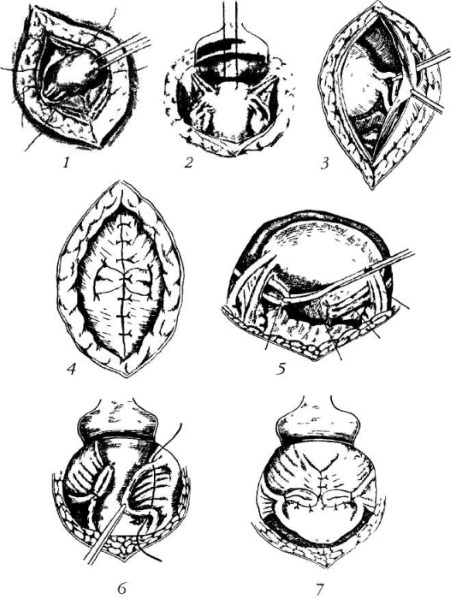
During the operation, the abdominal cavity is dissected, the ligaments are sewn to the peritoneum so that the body of the uterus takes the correct position.
The operation has a drawback. After the suspension, a pronounced attachment of the body of the genital organ to the peritoneum is noted, which does not make it possible to do any active physical exercises in the future. But, as practice shows, over time, this complication recedes.
Exohysteropexy
Exohysteropexy has one very unpleasant side effect. After the procedure, conception is impossible. The operation is performed only for women who have already entered the period of menopause or after sterilization.
The procedure is carried out by sheathing the uterus with the peritoneum, while the bottom remains outside the abdominal cavity. Fiber and aponeurosis are stitched over the body, staples are applied to the skin.
Some gynecologists do not consider the procedure to be highly effective.
Exercise therapy for retroflection of the uterus
Very effectively copes with the problem of exercise therapy and physiotherapy. Therapeutic gymnastics allows you to restore the tone of the uterus, normalize intra-abdominal pressure, and restore the correct position of the uterus in the small pelvis.
Algorithm for conducting Kegel exercises:
- Contract and relax the perineum. It is worth starting the exercise with 8-10 times, then increase the number of contractions and relaxations up to 15 times.
- Reduce the vaginal area from the bottom up. When performing, the woman should feel a gradual change in the tone of the uterus.
- Alternately contract the muscles near the anus, urethra and perineum.
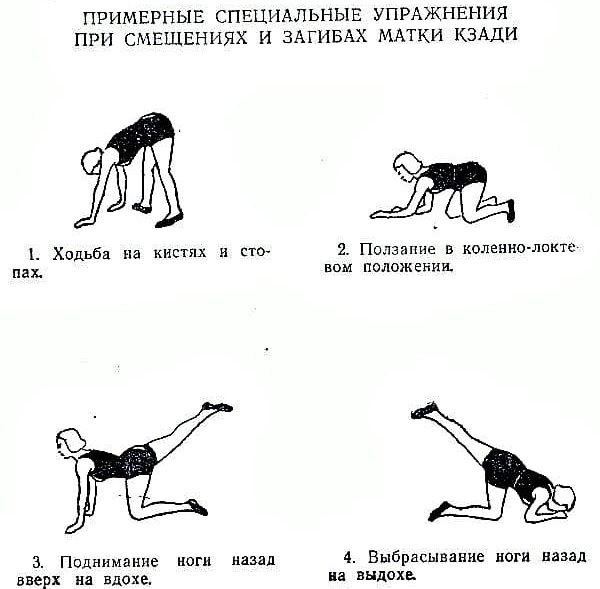
Therapeutic exercises can be performed in any position (lying, sitting, or standing). Each set of exercises is carried out for 4-5 minutes. 3-4 visits are performed per day. Exercise therapy is not recommended during menstruation. In each case, the doctor determines an individual set of exercises.
Traditional methods
The bending of the uterus is often accompanied by an inflammatory process. Therefore, the goal of treatment with folk remedies is aimed at eliminating inflammation and improving the microflora of the vagina. It will not be possible to completely restore the correct position of the organ by herbal medicine alone, but they will significantly improve the condition of the mucous membrane and restore the tone of the uterus.
Traditional medicine:
| Means | Recipe | Application |
| Oak bark | 1 tbsp. l. pour raw materials with 1 liter of water. Boil for 20 minutes, cool and drain. Pour the infusion into a liter jar and add warm water to the top. | Douche 2 times a day. The course is 10 days. |
| Marshmallow root | Pour 50 g of raw materials with 0.5 liters of water and leave to infuse for a day. Then simmer for 2-3 hours. After add 2 tbsp. l. lard and simmer for another 3 hours. | Take orally with meals for 3 tbsp. l. The course is 2 weeks. |
| Calendula | 1 tbsp. l. dilute calendula tincture with 50 ml of warm water. | Douche 2 times a day. The course is 5 days. |
Forecast
Retrodeviation does not affect life expectancy, but it negatively affects its quality. With strong bends, a woman feels soreness and discomfort, which appear not only during the period of intimacy. Also, retrodeviation negatively affects the work of organs close to the uterus. For women of reproductive age, there is a high risk of infertility.
Modern medicine, thanks to effective methods of surgical treatment, makes it possible to cope with retrodeviation of the uterus. This is a condition that can practically not have any negative consequences. With minor displacements, reproductive function remains normal.
But, nevertheless, when identifying such a problem, women should more carefully monitor the condition. organs of the reproductive system, regularly undergo examinations by a gynecologist and promptly treat related diseases.
Video about the bend of the uterus
Lecture on the bend of the uterus:
